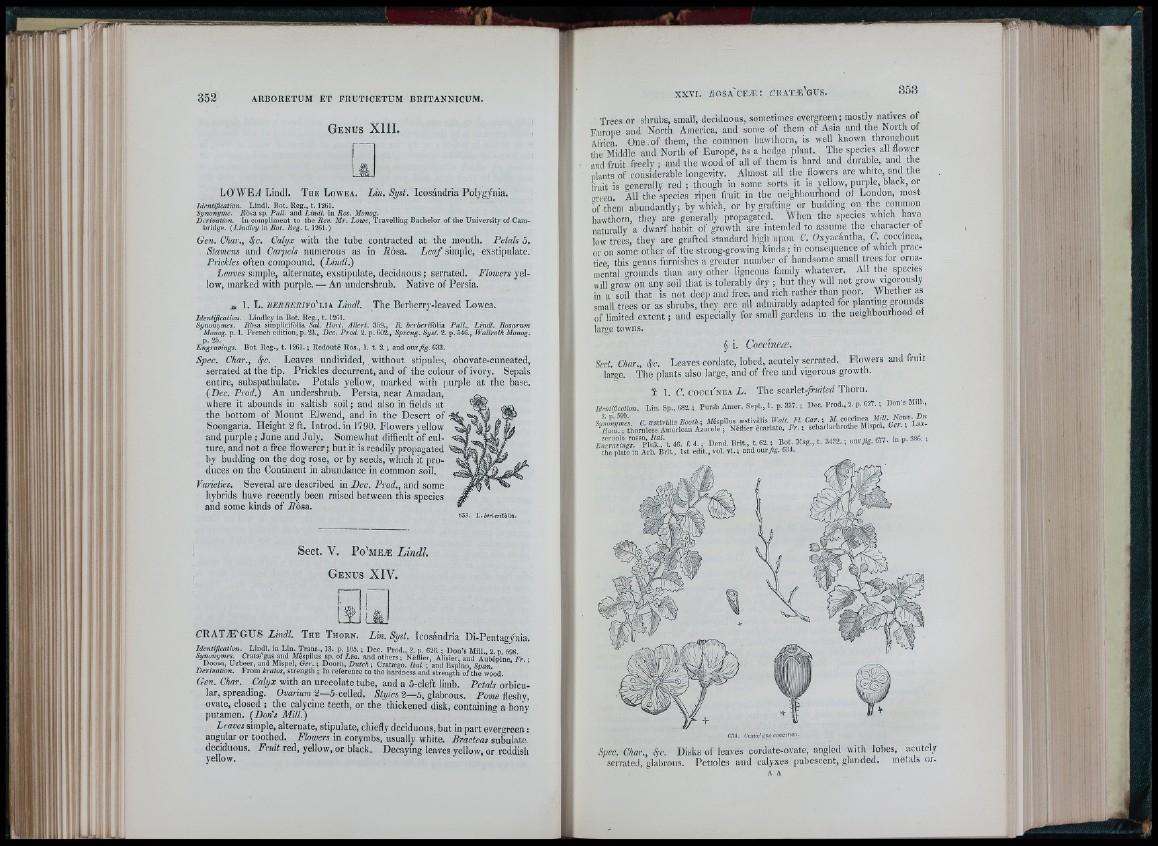
L
G e n t j s X l lL
L 0 'W E j4 Lindl. T h e L o w e a . Lin. Syst. Icosândria Polygynia.
Identification. Lindl. Bot. Reg., t. 1261.
Synonyme. Absa sp. PaU. and Lindl. in Ros. Mono^
jerivation. In compliment to th e Rev. Mr. Lowe, Travelling Bachelor of th e University of Cambridge.
(L in d le y in Bot. Reg. t. 12G1.)
Gen. Char., 4c. Calyx with the tube contracted at the mouth. Petals 5.
Stamens and Carpels numerous as in iid sa . L e a f simple, exstipulate.
Prickles often compound. {LindlZ)
Leaves simple, alternate, exstipulate, deciduous ; serrated. Flowers yellow,
marked with puqile. — An undershrub. Native of Persia.
1. L. BERBERlvo^iAh Lhidl. The Berberry-leaved Lowea.
Identification. Lindley in Bot. Reg., t. 126!.
Synonymes. Ròsa simplicifòlia Sal. Iloìd. Allert. 359., R, berberìiòWst Pall., L in d l. Rosarum
Monog. p. 1. French edition, p. 23., Dec. Prod. 2. p. 602., Spreng. Syst. 2. p. 546., Wallroth Monog.
p. 25.
Engravings. Bot. Reg., t. 1261. ; Redouté Ros., 1. t. 2. ; and o u r^ g . 633.
Spec. Char., 4c- Leaves undivided, without stipules, obovate-cuneated,
serrated at the tip. Prickles decurrent, and of the colour of ivory. Sepals
entire, subspathulate. Petals yellow, marked with purple a t the base,
{Dec. Prod.) An undershrub. Persia, near Amadan,
where it abounds in saltish so il; and also in fields at
the bottom of Mount Elwend, and in th e Desert of ^
Soongaria. Height 2 ft. Introd. in 1790. Flowers yellow
and purple ; June and July. Somewhat difficult of culture,
and not a free flowerer; but it is readily propagated
by budding on the dog rose, or by seeds, which it produces
on the Continent in abundance in common soil.
Varieties. Several are described in Dec. Prod., and some
hybrids have recently been raised between this species
and some kinds o f i?òsa.
633. I . ierÒCTifòlia.
Sect. V. P o 'm e æ Lindl.
G e n u s X IV .
IJL
C R A TÆ 'G U S Lindl. T h k T h o r n . Lin. Syst. Icosândria Di-Pentagynia.
Identification.^ Lindl. in Lin. Trans., 13. p. 105. ; De c. P rod., 2. p. 626. ; D o n ’s Mill., 2. p. 598.
.s „„A e r .- a n d O th e r s ; Néflier, Alisier,Cratæ'gus and il/éspilus sp. of L . ...... a n d Aubépine, Fj*. ;
l)ooi*n, Uzbeer, and Mispel, Ger. ; Doom, D utch; Cratægo. Ital. ; and Espino. Snan
Dertvation. From kratos, strength ; in reference to th e hardness and strength of th e wood.
Gen. Char. Cal.y x with. an urceolate tube,. and a 5-c left lim b. Petals orbicular,
spreading. Ovarium 2—5-ceIled. Styles 2—5, glabrous. Porne fleshy
ovate, closed ; the calycine teeth, or the thickened disk, containing a bony
putamen. (Doris MiU.)
Leaves simple, alternate, stipulate, chiefly deciduous, but in part evergreen:
angular or toothed. Flowers in corymbs, usually white. Bracteas subulate,
deciduous. Fruit red, yellow, or black. Decaying leaves yellow, or reddish
vellow.
Trees or shrubs, small, deciduous, sometimes evergreen ; mostly natives of
Europe and North America, and some of thein of Asia and the N oito of
Africa. O n e .o f them, the common hawthorn, is well known throughout
the Middle and North of Europé, its a hedge plant. The species all flower
and fruit freely ; and the wood of all of them is hard and durable, and the
nlants of considerable longevity. Almost all the flowers are white, f t d the
fruit is generally red ; though in some sorts it is yellow, purple black, or
areen All the species ripen fruit in the neighbourhood of London, most
of tlmm abundantly; by which, or by grafting or budding on the common
hawthorn, they are generally propagated. When the species which have
naturally a dwarf habit of growth are intended to assume the character ot
low trees, they are grafted standard high upon C. Oxyacàntha, C. coccínea,
or on some other of the strong-growing kinds ; in consequence ot whmh practice
this genus furnishes a greater number of handsome small trees for ornamental
«rounds than any other ligneous family whatever. AU the specift
will g ro ¿ on any soil that is tolerably dry ; but they will not grow vigorously
in a soil th a t is not deep and free, and rich rather than poor. Whether as
small trees or as shnibs, they are all admirably adapted for plaftmg f to u f t s
of limited extent ; and especially for small gardens in the neighbourhood ot
large towns.
§ i. Coccineoe.
Sect. Char., f r . Leaves cordate, lobed, acutely serrated. Flowers and fniit
large. The plants also large, and of free and vigorous growth.
Ï 1. C. c o c c i ' n e a L . The scxAet-fndted Thorn.
HnUificatim,. Lin. Sp., 682. ; PnrBi, Amer. Sept., 1. p. 337. ; Dec. P rod., 2. p. 627. ; Don's Mill.,
C. æstivàlls lìoolh : Méspilus æstivàlis Walt FI. Car
Ham. ; thornless American Azarole ; Néflier ecarlate, Fr . \ scharlachrothe Misp ,
t e / s “ “p l S Î ' t 46. f. 4. 1 Dend. Brit., t. 62. i Bot Mng., t. 3432., o u r,fe . 677. in p. 3S6. i
tîie plaÆ in Arb. Brit., 1st ed it., vol. v i.i and om fig . 634.
En
631. Gratic'KUsrocciuea.
Spec. Char., 4c. Disks of leaves cordate-ovate, angled with lobes, acutely
serrated, glabrous. Petioles and calyxes [lubescent, glanded, metals or.
A A